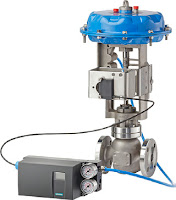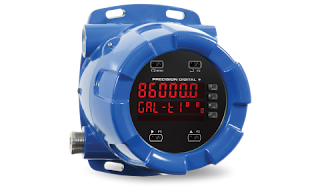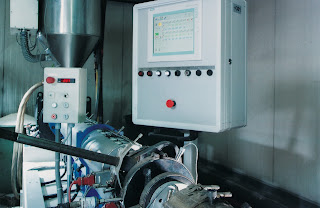The Samson 82.7 double eccentric rotary plug control valve is designed for standard and critical service applications, including process events such as erosion, abrasion, corrosion, cavitation, and flashing. The double eccentric rotary plug design increases flow capacities with only minor reduction in the pressure recovery factor making the design an ideal replacement for linear globe control designs even with cavitation and flashing process conditions present.
The 82.7 control valve has several standard options such as temperature extensions, heating jacket, special packing designs, noise attenuation and cavitation prevention trim sets, etc. The Vetec 82.7 can be assembled with a pneumatic, electric, hydraulic, or electro-hydraulic actuator also offered by the SAMSON group to complete the control valve construction. These control valves are designed according to the modular assembly principle, can be equipped with SAMSON GROUP actuators and valve accessories such as positioners, limit switches, and solenoid valves.
For more information contact Ives Equipment. Call their main office at (877) 768-1600 of visit their web site at https://ivesequipment.com.
Educational information on process control, industrial instrumentation, valves, valve automation and control valves. For additional information visit IvesEquipment.com or call 877-768-1600
The Siemens Milltronics MSI Belt Scale
The Siemens Milltronics MSI is a high accuracy, full frame, heavy-duty single idler belt scale used for process and load-out control suitable for monitoring products as diverse as sand, flour, coal, or even sugar. The Siemens Milltronics MSI belt scale provides continuous in-line weighing on a variety of products in primary and secondary industries and is proven in a wide range of extremely tough applications in mines, quarries, pits, power generating stations, iron and steel foundries, food processing plants, and chemical production facilities.
The Siemens Milltronics MSI patented use of parallelogram-style load cells results in fast reaction to vertical forces, ensuring instant response to product loading. This enables it to provide outstanding accuracy and repeatability even with uneven loading and fast belt speeds.
For more information, contact Ives Equipment by calling (877) 768-1600 or visit https://ivesequipment.com.
Labels:
belt scale,
Delaware,
Maryland,
Milltronics,
MSI,
New Jersey,
New York,
Pennsylvania,
Siemens,
Virginia
The Alfa Laval Unique Mixproof CP-3 Valve
Offering all dairy, food and beverage processors optimum hygiene, reliable effectiveness and decreased ownership expenses. Not just a dairy valve, the Alfa Laval Unique CP-3 is a reduced vent mix-proof valve – designed to be configurable and to protect your product.
Food and beverage plants across the United States are now using this proven mix-proof technology to eliminate cross-contamination – while improving overall production safety, hygiene, and production.
Beverage:
The Unique mix-proof CP-3 can be configured to handle carbonated drinks or energy drinks based on sugar and syrup – perfect for syrup or recipe room manifolds. Cleaning plugs and seats during seat-lifting eliminates sugar or syrup build-up.
Cleaning time and eventually modifications in the recipe are quicker as only two seals are situated in the valve chamber – enabling quicker valve cleaning during seat lift with fewer seal spare parts needed, improving valve longevity.
Food:
The Unique mix-proof CP-3 also has a setup to handle the most viscous condiments such as ketchup and mayonnaise and can assist address complicated problems in food processing – such as keeping the texture and taste of soups or vegetable sauces.
While it can be hard for any viscous food application to clean mix-proof valves with narrow plug tolerances, the starches left behind pose the greatest cleaning challenge. The valve seat is built on the upper and lower seat plugs with throttling corners – which speeds up cleaning fluid to enhance CIP effectiveness and clean the most stubborn food residue with the absolute minimum quantity of CIP fluid resources being used.
For more information, contact:
Ives Equipment
https://ivesequipment.com
(877) 768-1600
Explosion-Proof Meters, Annunciators and Batch Controllers Built to Work in a Wide Range of Applications and Environments
Front, back and in between, the PD8-6000 explosion-proof process meter boasts specifications, features and functionality that make it the only hazardous area process meter you will ever need.
The PD8-6000 is approved as a complete product by FM and CSA and also carriers IECEx approvals. Besides being suitable for hazardous areas, the number one feature that makes the PD8-6000 such a useful device is its built-in 24 VDC power supply to drive the transmitter as illustrated by the above diagram. This feature not only saves the cost of an external power supply, but also greatly simplifies wiring. In addition, there is a second 25 mA power supply provided with the 4-20 mA output option
Its superluminous LED digits make it easily readable in smoke, dust, fog, and, with the optional SunBright® display, even direct sunlight. It accepts a process current (4-20 mA) or process voltage (0-5V, 1-5V, etc.) signal and displays it on a dual-line, 6-digit SunBright® sunlight readable display.
The meter includes a 24 VDC power supply to drive the transmitter and can be equipped with up to four internal relays and a 4-20 mA output. The PD8-6000 can be programmed and operated without opening the housing by using the built-in SafeTouch® through-glass buttons or the RS485 serial communication port with free Modbus® protocol.
A fully loaded PD8-6000 meter has the following: four SPDT relays, 4-20 mA output, and two 24 VDC power supplies. The four relays can be used for alarm indication or process control applications such as pump alternation control. The 4-20 mA isolated output, Modbus RTU serial communications, and digital I/O options make the PD8-6000 an excellent addition to any hazardous area application.
For more information, contact Ives Equipment by calling 877-768-1600 or by visiting https://ivesequipment.com.
The PD8-6000 is approved as a complete product by FM and CSA and also carriers IECEx approvals. Besides being suitable for hazardous areas, the number one feature that makes the PD8-6000 such a useful device is its built-in 24 VDC power supply to drive the transmitter as illustrated by the above diagram. This feature not only saves the cost of an external power supply, but also greatly simplifies wiring. In addition, there is a second 25 mA power supply provided with the 4-20 mA output option
Its superluminous LED digits make it easily readable in smoke, dust, fog, and, with the optional SunBright® display, even direct sunlight. It accepts a process current (4-20 mA) or process voltage (0-5V, 1-5V, etc.) signal and displays it on a dual-line, 6-digit SunBright® sunlight readable display.
The meter includes a 24 VDC power supply to drive the transmitter and can be equipped with up to four internal relays and a 4-20 mA output. The PD8-6000 can be programmed and operated without opening the housing by using the built-in SafeTouch® through-glass buttons or the RS485 serial communication port with free Modbus® protocol.
A fully loaded PD8-6000 meter has the following: four SPDT relays, 4-20 mA output, and two 24 VDC power supplies. The four relays can be used for alarm indication or process control applications such as pump alternation control. The 4-20 mA isolated output, Modbus RTU serial communications, and digital I/O options make the PD8-6000 an excellent addition to any hazardous area application.
For more information, contact Ives Equipment by calling 877-768-1600 or by visiting https://ivesequipment.com.
Labels:
Delaware,
explosion proof,
hazardous areas,
Maryland,
New Jersey,
New York,
panel meter,
Pennsylvania,
Virginia
Reducing Material Waste in Flexible Pet (Polyethylene Terephthalate) Production
Polyester is very popular because it is a light, soft, flexible, low-maintenance material that keeps you warm. Making it this way poses diverse challenges to PET producers.
A chemical plant specializing in producing PET was looking for a solution to reduce the waste resulting from product variance. The factory produces 25,000 tons of polyester annually, which is then provided to other manufacturers to produce a vast range of end products.
 |
| The SITRANS FC430 monitors the glycol flow. |
These source materials are stored in stainless steel bins with a volume of 2649 ft3. Rotary feeders move the mate- rial from these bins to a batching vessel along with glycol to make the polyester paste. The batching vessel is agitated to ensure that the mixture is always consistent. Monitoring tank levels, precisely controlling the dosing, the efficient use of raw materials and ensuring a consistent mix are the key parameters
 |
| SIWAREX WP251 |
Don’t get mixed up during mixing
Each raw material bin is mounted on Siwarex WL280 ring torsion load cells to achieve optimum weighing accuracy. These load cells are connected to two Siwarex WP251 weighing modules, which are specifically designed for batching applications. The advantages of this solution are that the WL280 load cells feature a C3 class rating for accuracy as well as an IP68 rating for protection against dust and direct high-pressure cleaning – ideal for handling powder materials such as PTA. In connection with the Siwarex WP251, a customer-specific application was engineered with a resolution of up to +/- 4 million parts.
 |
| SITRANS TS500 |
How powder and liquid become PET
 |
| Pointek CLS200 |
Less material waste and reduced downtimes
 |
| SIPART PS2 |
 |
| Simplified diagram showing the customer’s process. |
Ives Equipment
877-768-1600
https://ivesequipment.com
Oil & Gas and Power Grids Have New "Cause for Concern" from Hackers
A report released in June, from the security firm Dragos, describes a worrisome development by a hacker group named, “Xenotime” and at least two dangerous oil and gas intrusions and ongoing reconnaissance on United States power grids.
Multiple ICS (Industrial Control Sectors) sectors now face the XENOTIME threat; this means individual verticals – such as oil and gas, manufacturing, or electric – cannot ignore threats to other ICS entities because they are not specifically targeted.
The Dragos researchers have termed this threat proliferation as the world’s most dangerous cyberthreat since an event in 2017 where Xenotime had caused a serious operational outage at a crucial site in the Middle East.
The fact that concerns cybersecurity experts the most is that this hacking attack was a malware that chose to target the facility safety processes (SIS – safety instrumentation system).
For example, when temperatures in a reactor increase to an unsafe level, an SIS will automatically start a cooling process or immediately close a valve to prevent a safety accident. The SIS safety stems are both hardware and software that combine to protect facilities from life threatening accidents.
At this point, no one is sure who is behind Xenotime. Russia has been connected to one of the critical infrastructure attacks in the Ukraine. That attack was viewed to be the first hacker related power grid outage.
This is a “Cause for Concern” post that was published by Dragos on June 14, 2019.
“While none of the electric utility targeting events has resulted in a known, successful intrusion into victim organizations to date, the persistent attempts, and expansion in scope is cause for definite concern. XENOTIME has successfully compromised several oil and gas environments which demonstrates its ability to do so in other verticals. Specifically, XENOTIME remains one of only four threats (along with ELECTRUM, Sandworm, and the entities responsible for Stuxnet) to execute a deliberate disruptive or destructive attack.
XENOTIME is the only known entity to specifically target safety instrumented systems (SIS) for disruptive or destructive purposes. Electric utility environments are significantly different from oil and gas operations in several aspects, but electric operations still have safety and protection equipment that could be targeted with similar tradecraft. XENOTIME expressing consistent, direct interest in electric utility operations is a cause for deep concern given this adversary’s willingness to compromise process safety – and thus integrity – to fulfill its mission.
XENOTIME’s expansion to another industry vertical is emblematic of an increasingly hostile industrial threat landscape. Most observed XENOTIME activity focuses on initial information gathering and access operations necessary for follow-on ICS intrusion operations. As seen in long-running state-sponsored intrusions into US, UK, and other electric infrastructure, entities are increasingly interested in the fundamentals of ICS operations and displaying all the hallmarks associated with information and access acquisition necessary to conduct future attacks. While Dragos sees no evidence at this time indicating that XENOTIME (or any other activity group, such as ELECTRUM or ALLANITE) is capable of executing a prolonged disruptive or destructive event on electric utility operations, observed activity strongly signals adversary interest in meeting the prerequisites for doing so.”
Multiple ICS (Industrial Control Sectors) sectors now face the XENOTIME threat; this means individual verticals – such as oil and gas, manufacturing, or electric – cannot ignore threats to other ICS entities because they are not specifically targeted.
The Dragos researchers have termed this threat proliferation as the world’s most dangerous cyberthreat since an event in 2017 where Xenotime had caused a serious operational outage at a crucial site in the Middle East.
The fact that concerns cybersecurity experts the most is that this hacking attack was a malware that chose to target the facility safety processes (SIS – safety instrumentation system).
For example, when temperatures in a reactor increase to an unsafe level, an SIS will automatically start a cooling process or immediately close a valve to prevent a safety accident. The SIS safety stems are both hardware and software that combine to protect facilities from life threatening accidents.
At this point, no one is sure who is behind Xenotime. Russia has been connected to one of the critical infrastructure attacks in the Ukraine. That attack was viewed to be the first hacker related power grid outage.
This is a “Cause for Concern” post that was published by Dragos on June 14, 2019.
“While none of the electric utility targeting events has resulted in a known, successful intrusion into victim organizations to date, the persistent attempts, and expansion in scope is cause for definite concern. XENOTIME has successfully compromised several oil and gas environments which demonstrates its ability to do so in other verticals. Specifically, XENOTIME remains one of only four threats (along with ELECTRUM, Sandworm, and the entities responsible for Stuxnet) to execute a deliberate disruptive or destructive attack.
XENOTIME is the only known entity to specifically target safety instrumented systems (SIS) for disruptive or destructive purposes. Electric utility environments are significantly different from oil and gas operations in several aspects, but electric operations still have safety and protection equipment that could be targeted with similar tradecraft. XENOTIME expressing consistent, direct interest in electric utility operations is a cause for deep concern given this adversary’s willingness to compromise process safety – and thus integrity – to fulfill its mission.
XENOTIME’s expansion to another industry vertical is emblematic of an increasingly hostile industrial threat landscape. Most observed XENOTIME activity focuses on initial information gathering and access operations necessary for follow-on ICS intrusion operations. As seen in long-running state-sponsored intrusions into US, UK, and other electric infrastructure, entities are increasingly interested in the fundamentals of ICS operations and displaying all the hallmarks associated with information and access acquisition necessary to conduct future attacks. While Dragos sees no evidence at this time indicating that XENOTIME (or any other activity group, such as ELECTRUM or ALLANITE) is capable of executing a prolonged disruptive or destructive event on electric utility operations, observed activity strongly signals adversary interest in meeting the prerequisites for doing so.”
Subscribe to:
Posts (Atom)





